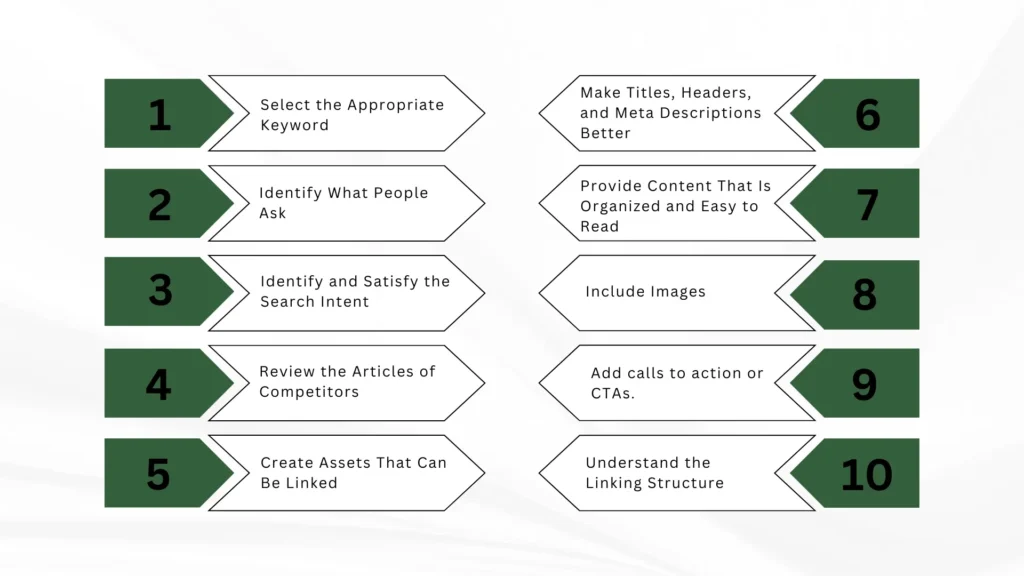10 Tips to Improve Your Content: A Comprehensive Guide

In our present digital environment, producing content involves more than just writing words on a website; it also entails developing meaningful experiences that connect with your audience and produce outcomes. These ten tried-and-true suggestions will help you elevate your material from mediocre to outstanding, regardless of your level of experience.
1. Select the Appropriate Keyword
Selecting the ideal keyword is the first step toward success. Choose more than one keyword that immediately jumps to mind. Instead, find terms that strike a balance between search traffic and competitiveness by using tools like SEMrush or Google Keyword Planner. Search for long-tail keywords; they may have fewer searches, but because they are more focused on user needs, they often convert better.
For example, to bring in more targeted visitors, try targeting “best automatic espresso machines under $500” rather than “coffee machines.”
2. Identify What People Ask
Developing good content requires knowing what your audience wants to know. To find actual questions people are asking about your subject, visit websites such as Quora, Reddit, and Answer The Public. Take note of the language they use and the particular issues they are trying to resolve.
Keep an eye on your social media accounts and blog comments; these are great places to find ideas for content that speaks to your readers. You’ll attract interested readers if you produce material that answers these questions directly.
3. Identify and Satisfy the Search Intent
There is a reason behind each search query. Are people trying to find a specific website (navigational intent), learn something (informational intent), or purchase something (commercial intent)? To find out what kind of content Google finds most relevant, look at the pages that rank highest for your target phrase.
When someone searches for “how to make cold brew coffee,” they are not looking for a page with coffee makers on it; rather, they are looking for a detailed tutorial. Better engagement and rankings will result from aligning your content structure with the searcher’s objective.
4. Review the Articles of Competitors
Learn from your competition instead of copying them. Examine the most popular articles in your niche to determine the following:
- What subjects do they address
- How their content is organized
- What kinds of media are included in them
- Where gaps may exist, you can fill them
Next, come up with something better. Give fifteen tips if they give ten. Provide comprehensive infographics if their images are simple. Always try to differentiate your material by adding something special.
5. Create Assets That Can Be Linked
Content that is so useful that other websites want to link to it naturally is known as a linkable asset. These could consist of:
- Original studies and questionnaires
- In-depth manuals
- Unique infographics
- Interviews with experts
- Compilations of industry statistics
Make an effort to produce information that people in your field will find useful. The more naturally occurring backlinks you receive from your content, the more authority your website will have.
6. Make Titles, Headers, and Meta Descriptions Better
You must make your material clickable and discoverable. Make attention-grabbing titles that promise readers something of value while using your target keyword. Use descriptive headers (H2s and H3s) to break up your content so that readers can easily navigate and scan it.
Create meta descriptions for your content that serve as miniature advertising in search engine results. Make sure your term appears naturally and provide readers with an attractive reason to click through.
7. Provide Content That Is Organized and Easy to Read
Presentation is just as important to readability as word choice. Organize your material such that it is simple to understand:
- Make use of brief paragraphs (2–3 phrases at most).
- Add lots of white space.
- Make lists of the important points with bullets or numbers.
- Employ transitional phrases to move between sections.
- Use subheadings to divide lengthy sections.
Keep in mind that a lot of people will scan your content before choosing to read it in full. Make it simple for them to quickly understand your primary points.
8. Include Images
Text is broken up with visual content, which also clarifies difficult ideas and increases the probability that your content will be shared. For each piece of material, think about including:
- Images that are important
- Infographics
- Graphs and charts
- Screenshots
- Videos and Diagrams
Don’t just include pictures for the sake of having them; make sure they provide something of worth. Every image should support the story or better convey your ideas.
9. Add calls to action or CTAs.
Every piece of material needs to serve a certain function. After reading your material, what do you want readers to do? Use well-placed calls to action throughout your article to make it clear:
- Sign up for your newsletter.
- Download a relevant file.
- Get a free trial by registering.
- Distribute the material
- Go through related articles.
Put your main call to action where it makes the most sense, which is usually after you’ve gained the reader’s trust and added value.
10. Understand the Linking Structure
In addition to enabling reader research, intelligent linking helps search engines recognize the structure of your website. Include the following:
- Internal links to your website’s relevant content
- External links to trustworthy sources.
- When necessary, links to product pages
- Links to supporting data for claims
Make sure the clickable words in your anchor text are relevant to the connected page and descriptive.

In conclusion
It takes constant application of proven methods to produce high-quality material. By following these ten suggestions, you will produce content that offers your visitors genuine value in addition to ranking highly in search results. Keep in mind that the best content meets the needs of your audience as well as your company’s objectives.
Don’t attempt to get everything just right at once; start using these suggestions for your next piece of content. Concentrate on putting one or two suggestions into practice at a time until they become easy to you while you create content. Both your metrics and your readers will appreciate it.